Introduction
“The Lamb” by William Blake, a Famous American poet and writer, is an illustrative poetic piece. The poem speaks about the unmatchable beauty of the innocent lamb. This artistic poem sees in the figure of the lamb as an expression of the God’s will. It perfect appearance and positive traits reflect the mastery of God’s creation. The poem is told from a child perspective, who exhibits an intuitive perception of the joy of nature. The writer brilliantly builds up the idea that everything present in the universe reflects the image of its creator. The creation of gentle lamb makes him think of its creator and helps him reveal God’s benevolence and tender qualities. In fact, he gets amazed and dazzled at the sight of vulnerable lamb. This amazement led him pose a series of questions about its existence and then answers for lamb.
To read full poem, please click here.
Major Themes in “The Lamb”
Wonderful natural world, mastery of God and praise of God are the major themes found in the poem. The poet has applied these ideas with the help of various powerful literary and poetic devices. To him, the lamb is an epitome of innocence, purity and virtue. He finds not even a single flaw in its creation; this perfection made him pose various questions regarding its master. At first, he asks the lamb if he knows anything about its master. As the poem continues, he himself answers the questions and compares the lamb’s innocence with God. Moreover, he adores God for His positive attributes, believing that He is also caring, loving, and a peaceful deity like the lamb.
Analysis of Literary and Poetic Devices Used in “The Lamb”
To enhance the intended impact of this symbolic poetic piece, the writer has added various literary and poetic devices in it. Some of the prominent devices used in the poem are;
- Allusion
- Imagery
- Metaphor
- Symbolism
- Repetition
The first and significant device that seems dominant in the poem is Allusion. An allusion is a belief and an indirect reference of a person, place, or thing important in a historical or religious context. The lamb in the poem directly alludes to Jesus. The writer compares the lamb’s innocence and perfection with that of holy Jesus. The second most important device used in the poem is imagery. The writer has used visual as well as auditory imagery to captivate his audience.
Offering tangible portraying of specific ideas and emotions, William Blake has used metaphors in the poem. The lamb and the child both are the metaphor for religion and innocence. The lamb can also be seen as a metaphor for Jesus. Similarly, to make his readers connect to his distinct ideas, the writer has divided this poem into two stanzas, with each having five rhyming couplets.
Moreover, to bring musical quality in the poem, he has used end rhyme such as; “feed/mead,” “delight/ bright,” and “voice/ rejoice.” Repetition of some verses has also brought sing sung quality in the text. The lines “Little Lamb I’ll tell thee” and “Little Lamb God bless thee” are repeated to make the audience understand the stressed point.
In-depth Analysis of “The Lamb” by William Blake
Stanza #1
In this stanza the speaker address the innocent lamb directly and asks various questions from it. He asks if it possesses any knowledge about its creator; he asks if it knows who gave it this beautiful life and food to satisfy its hunger. After asking these basic questions, the speaker presents this innocent creature in a natural setting, frolicking beside sparkling stream and running though the grassy fields. The speaker expresses his wonder by using a powerful diction. He wonders whosoever created this thing of beauty has given it its coat of white snowy wool. Also, the creator has bless this lamb with soft and tender voice that makes the surrounding happy and vibrant.
Stanza#2
After counting all these blessings, the speaker once again wonders who created this beautiful creature. He inquiries from the lamb once again that if he knows anything about its creator. After receiving no reply from the lamb, he intends to answer his question; he address the lamb and intends to give information about its creator.
Stanza#3
In this stanza, the speaker excitedly unveils the answer of that question that brought him both delight and wonder at the same time. He tells the lamb that its creator shares the same name as the lamb, and indeed names Himself as Lamb. This creator is kind and gentle and was once a small child. The speaker and the lamb are also tasting the fruits of childhood, intending that he and the lamb share the name of their creator. After revealing this secret to the lamb, he asks God twice to bless this beautiful lamb.
Suggested Readings

